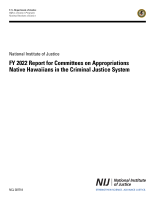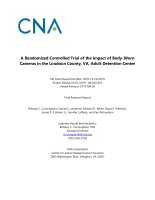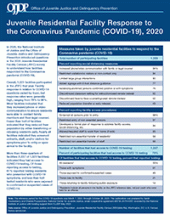Correctional facilities
FY 2022 Report for Committees on Appropriations Native Hawaiians in the Criminal Justice System
Date Published
October 2023
Agencies
NIJ
NIJ Multisite Impact and Cost-Efficiency Evaluation of Veterans Treatment Courts
15PNIJ-22-GK-00035-VTCX
Open
Funding First Awarded
2023
$1,500,000
A Randomized Controlled Trial of the Impact of Body-Worn Cameras in the Loudoun County, VA, Adult Detention Center
Date Published
2023
Agencies
NIJ-Sponsored
A 28-year longitudinal study of victimization and perpetration of violence in high-risk youth: Advancing the development of preventive interventions in the community
15PNIJ-23-GG-04269-CVIP
Open
Funding First Awarded
2023
$1,000,000
A Mixed-Method Examination of the Effectiveness of Money Bail and other Pretrial Release Options
15PNIJ-23-GG-02233-NIJB
Open
Funding First Awarded
2023
$560,195
A Randomized Controlled Trial of the HeartMath Resilience Program: Exploring the Impact of Stress on Jail Staff Performance and Retention
15PNIJ-23-GG-02231-NIJB
Open
Funding First Awarded
2023
$498,491
A Nationwide Assessment of Jail Reentry Policies and Practices: A Two-Tiered Study of the Field
15PNIJ-23-GG-02232-SCAX
Open
Funding First Awarded
2023
$599,986
Expanding Mental Health Diversion Opportunities: A Prospective Evaluation of the Los Angeles County Intake Booking Diversion Program
15PNIJ-23-AG-03563-RESS
Open
Funding First Awarded
2023
$754,209
Cannabis liberalization policies and trends in cannabis-related school-based discipline: Examining sociodemographic disparities in Massachusetts
15PNIJ-23-GG-01954-TITL
Open
Funding First Awarded
2023
$111,000
THRIVE: Transformative Health and Reproductive Information for Incarcerated Women's Empowerment.
15PNIJ-23-GG-01937-RESS
Open
Funding First Awarded
2023
$144,891
Pretrial Policy Change and Place: Evaluating the Impacts of Maryland's Bail Reform on Crime and Pretrial Outcomes across Courts
15PNIJ-23-GG-01931-RESS
Open
Funding First Awarded
2023
$55,500
Data and Dashboards: Research and Enhancements to Ensure Mecklenburg County’s Criminal Justice System is a Leader in Data-Driven Decision Making
15PNIJ-23-GG-00272-BRND
Open
Funding First Awarded
2023
$1,000,000
Introduction to Portal Contraband Detection Technology (June 2010)
Date Published
June 2010
Agencies
NIJ-Sponsored
Juvenile Residential Facility Response to the Coronavirus Pandemic (COVID-19), 2020
Date Published
May 2023
Agencies
NIJ-Sponsored,
OJJDP-Sponsored
Restoring Promise: A Randomized Control Trial Examining the Impact of an Innovative Young Adult Housing on Reducing Violence
Date Published
June 2023
Agencies
NIJ-Sponsored
Remarks of James K Stewart Concerning The National Institute of Justice
Date Published
1985
Agencies
NIJ-Sponsored





